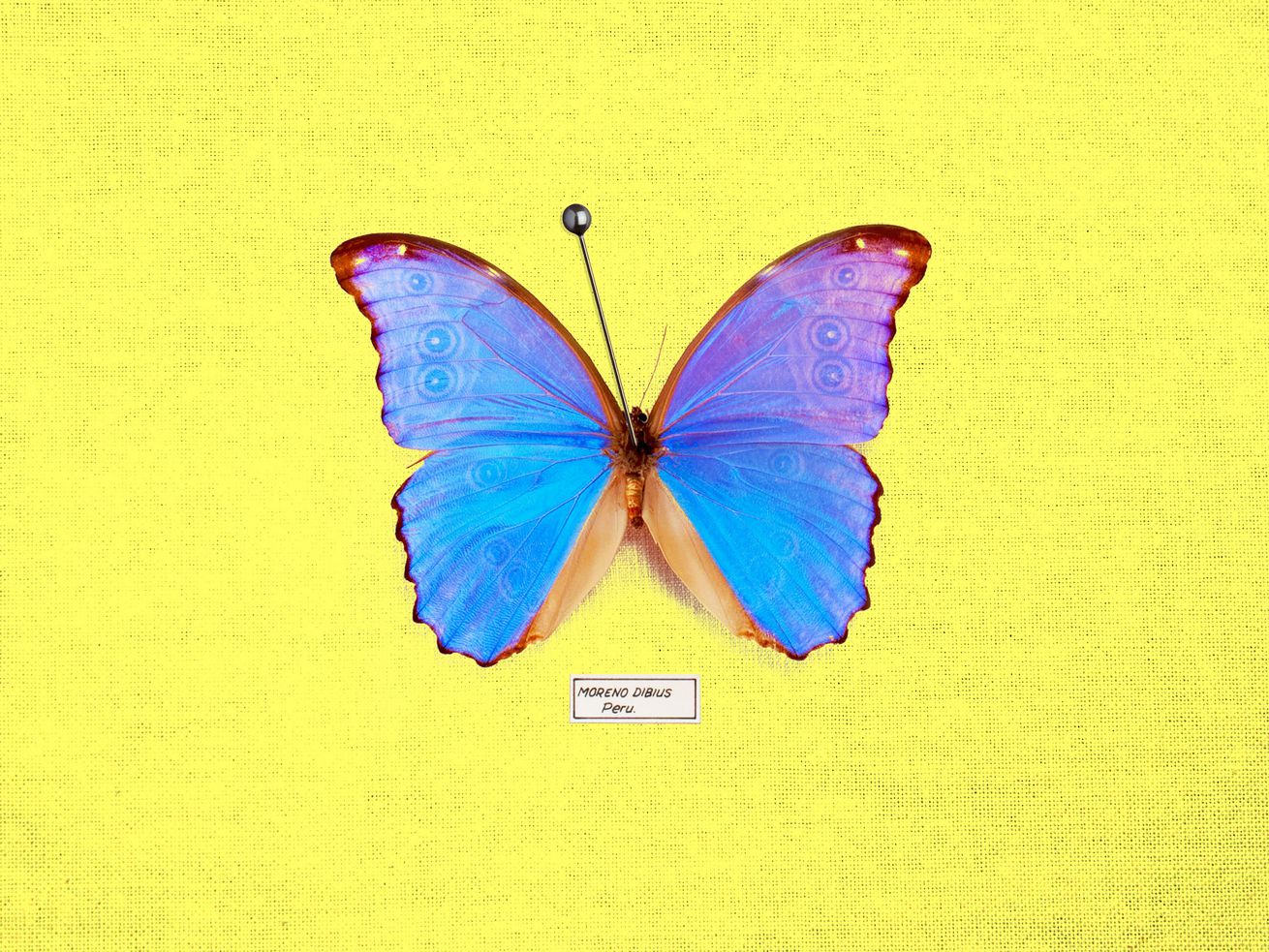Is it still ethical to collect butterflies for science?
/cdn.vox-cdn.com/uploads/chorus_asset/file/21899595/VOX_The_Highlight_Box_Logo_Horizontal.png)
Part of the May 2022 issue of The Highlight, our home for ambitious stories that explain our world.
The butterfly’s wings are splayed at an unnatural angle, orange-and-black markings visible to full effect. A metal pin skewers it to the wall. Through thick display glass, I read the tiny, hand-drawn label affixed to the pin’s base. This monarch, I learn, was collected from Michoud, Louisiana, in 1938.
Specimens like this one, housed at the Smithsonian National Museum of Natural History in Washington, DC, represent priceless bits of scientific data. Studying them has revealed everything from changes in butterfly wing shape over time to the genetics of extinct species to new species altogether. They are also now the subject of a passionate debate.
For centuries, butterfly collectors — also known as lepidopterists — have pursued their quarries with a standard set of equipment: vials of alcohol, cyanide bricks, metal pins, jars, and the iconic butterfly net. These insect enthusiasts meticulously catalog each butterfly specimen in the name of science (and, occasionally, fun). Their pinned prizes make up the bulk of museum butterfly collections to this day.
As a former entomology student, I am intimately familiar with catching butterflies. I have maintained my own collection for nearly a decade, donating extra specimens to local science museums. But despite years of experience, the metal pins and poison jars have always made me slightly queasy. Turns out, I’m not alone.
The last 30 years have seen the rise of butterflying, a spiritual sibling to bird watching that involves identifying and photographing the insects rather than capturing them. Some of its staunchly anti-net advocates liken capturing, killing, and pinning butterflies to trophy hunting, and accuse collectors of accelerating environmental collapse.
“I’m not saying that we want to throw away the collections that are there,” says Jeffrey Glassberg, founder of the North American Butterfly Association. “But randomly collecting butterflies in the United States is nothing but self-serving nonsense.”
Some recent studies estimate that since the 1970s, a large portion of insect populations around the globe have declined by approximately 45 percent. Many refer to this as the “insect apocalypse.” In the modern era of climate change and biodiversity loss, some entomologists and butterflyers wonder, is it ethical to collect insect specimens at all? The debate has split scientists and hobbyists alike, driving a wedge between conservation groups, research labs, museum curators — and even lifelong friends.
Approximately 750 butterfly species live in North America, 22 of which are currently listed as endangered or threatened; dozens more hover in the slightly more nebulous “at risk” category. Five species have gone extinct in the US since 1950. It would be a stretch, most experts agree, to put much of the blame on insect collectors. But for a few cases, the practice can tip an already precarious population into free fall.
In the United States, recreational, permit-free collecting is allowed pretty much everywhere: in national forests, in national parks, and on private land.
But collecting for scientific purposes is strictly regulated. And those regulations vary widely from state to state. For instance, permits are required in Oklahoma state parks, but Michigan state parks have no such restrictions. California has perhaps the most confusing collection laws.
“Insects were not included as wildlife in the original drafting of the laws,” says Chris Grinter, the entomology collection manager at the California Academy of Sciences. “They were shoehorned into a revision.” By this strange twist, California insects are technically categorized as fish.
In addition, the line between recreational and scientific collecting is often blurry. “A lot of global experts are amateurs that just don’t have a full-time job as an entomologist,” says Grinter.
Museum collections often rely on specimens donated by amateur (and sometimes famous) lepidopterists, like author Vladimir Nabokov, whose butterflies make up a chunk of the American Museum of Natural History’s 3.5 million butterfly and moth specimens. And it’s not uncommon for non-experts to stumble across specimens new to science. (In 2018, the Florida Museum of Natural History used new gene sequencing technology on an old pinned butterfly. To their surprise, they identified it as a new species — some 60 years after it was collected by a local teen.)
Amateur collecting is not without its downsides, however. Under certain circumstances, it can pose real risks to rare species.
Mitchell’s satyrs are small and brown — not the most visually stunning butterflies on Earth. But for avid insect collectors in the 1970s and 80s, they might as well have been gold-plated.
Mitchell’s satyrs have always been rare and, therefore, desirable. They were once found in pockets throughout the US Midwest and Northeast in wet forest clearings known as fens. But in the mid-1980s, the Fish and Wildlife Service noticed that the butterflies’ numbers had declined in several locations. The agency launched a years-long investigation to uncover the cause.
As an intern at the Sarett Nature Center in southwest Michigan, Nate Fuller says he witnessed these efforts. “There was an undercover Fish and Wildlife Service guy who would walk around the trails, keeping an eye out for anyone who looked suspiciously like they might be trying to steal a butterfly,” he recalls.
The agency ultimately found that habitat loss was the primary danger to Mitchell’s satyrs. But the agency also discovered that entire populations — including the only two in New Jersey — were potentially being wiped out by private collectors for whom the butterfly was a crown jewel. Today, Mitchell’s satyrs are confirmed in just 15 locations in Michigan, Indiana, Mississippi, and Alabama (and haven’t been seen in New Jersey since 1998). The butterflies were officially added to the Endangered Species List in 1992, making them illegal to collect. But some officials still worry about naive — or unscrupulous — collectors low-key swiping specimens.
/cdn.vox-cdn.com/uploads/chorus_asset/file/23456782/Joanna_Thompson_collection.jpg)
Courtesy of Joanna Thompson
“We’re intentionally vague about Mitchell’s satyr locations,” says Fuller, who is now the executive director at Sarett. And his park limits other potentially damaging activities, like hiking through fens. Mitchell’s satyrs are extremely delicate, and they make their chrysalises close to the ground, where a lumbering human foot is more than enough to crush them. Fuller says that occasionally, overly enthusiastic butterflyers stray from the center’s established trails in an effort to catch a glimpse of the rare insect and wind up doing unintentional harm.
“These little suckers are tough to keep alive,” he says.
As an undergraduate entomology student in the 2010s, I was routinely turned loose on North Carolina State University’s campus with specimen jars, a gauzy net, and instructions to swoop up every interesting bug I encountered. As a result, I learned the ins and outs of butterfly death.
I know how long to leave a specimen in the freezer to ensure its organs stop working, and how to activate the miniature brick of potassium cyanide fixed to the bottom of a killing jar. I know how to construct a label: location first, then species, date, and name. I know the slight give of an insect’s thorax as the metal pin slides through.
But the practice quietly unsettled me. There was, for example, the time I convinced myself I’d accidentally caught a rare species. Leaning over an impaled specimen, I flipped through my Butterflies of North Carolina and froze as I read the description: St. Francis’ satyr, endangered, a subspecies of the critically endangered Mitchell’s satyr.
Thankfully, I was mistaken. St. Francis’ satyrs are only found at Fort Bragg, 75 miles away. The butterfly was in fact a common Carolina satyr, a totally different species.
But what if I had caught a St. Francis’ satyr? Was my silly little collection worth that?
/cdn.vox-cdn.com/uploads/chorus_asset/file/23447878/secondary.jpg)
Amanda Northrop/Vox
Jeffrey Glassberg grew up on Long Island in the 1950s, chasing butterflies through the neighborhood with friends. He assumed he had outgrown his butterfly days when he enrolled in the civil engineering program at Tufts University. But although he would go on to earn two additional degrees in molecular genetics and law, he kept coming back to butterflies.
Glassberg founded the North American Butterfly Association, or NABA, in 1992 — the same year the Mitchell’s satyr was declared endangered — on the principle that people don’t need to catch butterflies in order to enjoy them. It’s also the driving message behind his first guidebook, Butterflies Through Binoculars, which shows readers how to identify butterflies by sight, much like a bird guide.
Straightaway, the organization and the book drew backlash; Glassberg says he received everything from tongue-lashings to death threats. How, critics exclaimed, could anyone study butterflies without collecting them?
Glassberg says that butterfly collection proponents point to the historical precedent of people like John J. Audubon, the famous wildlife illustrator and ornithologist, who shot birds in the early 1800s in order to study them in close detail. But that was an era before binoculars and high-resolution photography; today, anyone can become a birder with a guidebook and a decent pair of binoculars. “In my mind, that argument is truly stupid,” he says.
His message resonated with thousands of butterfly enthusiasts. Since the early 1990s, NABA has opened 23 chapters in 16 states. Today, the organization boasts over 4,500 members and its own kill-free, net-free nature sanctuary: the National Butterfly Center.
Opened in 2004, the National Butterfly Center occupies the site of an abandoned onion field in Mission, Texas, along the US-Mexico border. Its gardens burst with native plants teeming with butterflies and other pollinators, which cannot be collected on the premises. Their soothing insect hum is punctuated occasionally by the overhead chop of a border patrol helicopter.
When I arrived at the Center’s Texas Butterfly Festival in early November 2021, most of the 60-odd festival-goers had a pair of binoculars slung around their necks and a hefty-looking camera bag.
/cdn.vox-cdn.com/uploads/chorus_asset/file/23450991/Joanna_Thompson_3.jpeg)
Courtesy of Joanna Thompson
Our guide, Linda Cooper, showed us how to focus our cameras (or phones) at just the right depth for a perfect picture, how to find the flowers most likely to attract butterflies, and how to identify each species.
Slowly, I become more attuned to the creatures — because observation is the point.
Butterflying evokes the same breathless wonder that quickens my pulse every time I glimpse movement in the brush. But rather than strike with a net, I looked — really looked — at each insect, trying to spot the watermark that tells a queen from a soldier, or the Y-shaped pattern that sets a Turk’s cap skipper apart from a Laviana. It felt good to be filling my library with pictures rather than filling a box with bodies.
But even as I lost myself in the thrill, reminders of human threats, including climate change, were inescapable. Some host plants, including pipe vine, had been killed off by February’s extreme cold snap, which had left much of Texas without power. As a result, Cooper said, we were a lot less likely to encounter pipevine swallowtails, which are usually abundant.
/cdn.vox-cdn.com/uploads/chorus_asset/file/23467417/TD_D513276.jpg)
Courtesy of the National Butterfly Center
And on the horizon, the half-built border wall loomed. If completed, the concrete-and-rebar barrier will cut directly through the center’s gardens and could spell ecological disaster for many of its 300-plus butterfly species — including some found nowhere else on Earth — as well as the annual monarch migration.
Many butterfly specialists don’t oppose collecting butterflies in a strictly scientific capacity. And those folks include a close childhood friend of Jeff Glassberg, who grew up chasing bugs with him.
Robert Robbins is now the curator of Lepidoptera (butterflies and moths) at the Smithsonian National Museum of Natural History in Washington, DC, and, like Glassberg, he took an unconventional path to butterflies. He has never taken an etymology course in his life (he majored in math). But a chance encounter after graduate school with Glassberg got him interested in insects again — though, in time, the two would find themselves taking different stances.
“We don’t disagree on the facts,” says Robbins. “We just sort of have a different take on it.”
In only studying photographs, Robbins says, entomologists miss out on valuable sensory details. He points to his own research with hairstreak butterflies, in which males have a scent-producing organ on the upper side of their wings. Different hairstreak species have different scents; some are powerfully floral with notes of grape soda, others smell faintly of chocolate, while others give off the odor of sweaty gym shoes.
These bits of tangible data, he argues, are essential for inspiring the next generation of scientists. “By collecting, touching, smelling, and feeling, I think that kids get a much more valuable introduction to biology than they do just by using binoculars or cameras or whatever,” Robbins says. Despite their differences in opinion, Glassberg and Robbins have remained friends for 70 years; Robbins even served as a consultant for the National Butterfly Center.
Another butterfly researcher who views catching butterflies as a necessity is Arthur Shapiro, who grapples with the issue of specimen collection every two weeks, weather permitting. A professor at the University of California Davis, he lives in Northern California, where, over the last 50 years, he has amassed one of the world’s most thorough chronicles of butterfly population change. His data has shed light on regional variation in California butterflies and told the story of their gradual decline.
Regional variation in wing markings is virtually impossible to parse without side-by-side comparison, he says, and collection is a must for sequencing DNA. But as someone acutely aware of butterfly numbers, he is troubled by the thought of collecting specimens from diminishing populations. “I would be hesitant to remove individuals, especially females, for many species today,” he says.
Chris Grinter, the entomology collection manager at the California Academy of Sciences, sees work like Shapiro’s (and his own studies of micromoths) as indispensable chronicles of climate change. Grinter is a member of the Lepidopterists’ Society, a coalition of professional and amateur butterfly and moth researchers. He understands the instinct to push back against the practice of killing butterflies — but, he says he believes that collecting ultimately does way more scientific good than environmental harm. What’s more, Grinter thinks that focusing on collecting misses the larger picture.
“The real problem is habitat loss and destruction,” he says. About 20 million monarchs are killed by cars while migrating each year. That’s just a single species — thousands of others are affected by highways every day. The Lepidopterists’ Society has issued a statement that it sees collecting a few specimens here and there as insignificant by comparison.
/cdn.vox-cdn.com/uploads/chorus_asset/file/23450939/GettyImages_134233485.jpg)
Boston Globe via Getty Images
Like Shapiro and Robbins, though, Grinter wouldn’t advocate collecting indiscriminately. “There’s rare species and populations that need to be protected,” he says.
But a new tool might someday alleviate much of the need to choose between science and conservation.
The rapid rise (and decreasing cost) of DNA technology has brought about a new technique that could complement many butterfly studies and greatly reduce the number that are dying for science.
Environmental DNA, or eDNA, refers to the loose bits of an organism’s genetic material floating around in soil, water, or air, that enters the environment through things like shed skin cells and saliva. Theoretically, if scientists are able to collect an adequate sample from a given habitat, they could sequence these bits and identify all of the organisms living there. The technology is still in its infancy, but it is quickly becoming a viable research option — scientists were recently able to identify all of the animals in two different zoos using nothing but DNA pulled from the air.
This technique holds particular promise for studying butterflies, which leave genetic traces behind when they land. eDNA has already been used in Denmark to identify which butterflies visited a patch of wildflowers. The technology still has a few limitations to work out; it doesn’t work well in certain conditions, for example, and requires an existing DNA “bank” of different species’ genetic sequences for comparison.
Valeria Lencioni, an entomologist at the Museo Delle Scienze in Trento, Italy, is currently in the process of creating such a database for alpine insects.
She has dedicated her career to Alpine midges, tiny bugs that live in frozen streams and are one of the best indicator species for both climate change and water quality. Today they’re in peril, which makes her research more vital than ever. But to study them, she has to kill them by the millions.
If eDNA sequencing becomes widely available, she and her fellow researchers won’t have to choose between data and conservation for many studies (though some questions, like variations among individual butterflies, would still require collecting insects).
But that solution may be too far in the future for the butterflies and other insect species in danger now. Ultimately, the best way to save insects is to advocate for big-picture goals: protecting and restoring precious habitat while eliminating harmful emissions. In the meantime, though, I’ve decided to swap my butterfly net for a new pair of binoculars.
Joanna Thompson is a science journalist and sometimes fast runner. You can find more of her work at Scientific American, Live Science, Atlas Obscura, and Audubon.
Author: Joanna Thompson
Read More



